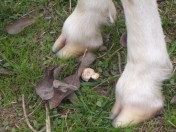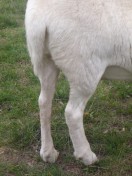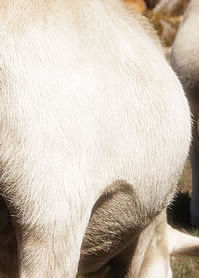
| ewes | rams | working dogs | sheep for sale | classic cars | sitemap | home |
Low Maintenance Sheep in Oregon |
Wool Sheep (Shearing) versus Hair Sheep (No Shearing) I have sheared my wool sheep in May with nice warm days, only to have it drop back down into the low 30's at night. Some of my older ewes were cold at night when the temperature would unexpectedly drop back down while conditioned to having their fleece for warmth. Their appetites greatly increased while burning more body fat to stay warm. This bothered me about shearing. My sheep stood tall next to a homemade table while I carefully removed their wool. They were not fasted or deprived of food or drink or in a sitting cramped position while sheared. As stress free as possible. Yet, just removing all that fleece put undue stress on my sheep and myself while trying to get the best temperature for the lanolin to flow for smoothe cutting and not have cold nights for my sheep after shearing. They would be really hungry after being shorn which told me they were burning good body fat to stay warm. For how long, I read 2 weeks to adjust but who knows? If I waited to shear, warm days with moisture and flies hatching, fly strike was a concern. With our hair sheep, they naturally shed their coats by spring. I'm thrilled after all these years I no longer have to shear or dispose of beautiful fleece which ended up in the burn pile. The wool price per pound didn't cover gas to remove it from our property. Our shearing equipment was expensive and required maintenance. Good sharp cutters and combs were a must and expensive. The equipment and wool couldn't pay for itself. Growing the fleece with more feed costs, shorn sheep burning good body fat with shearing costs and wool disposal mounting in time and money, I couldn't justify shearing my sheep anymore. It was a costly, time consuming, frustrating yearly maintenance. Our hair sheep are extremely agile and industrious when it comes to self grooming. With no wool tags around areas that tend to get dirty, our hair sheep are clean at lambing and year round...no maintenance.
Note: Having a closed herd, I taught myself to shear so I could avoid exposing my sheep and property to any diseases from outside shearers and shearing equipment.
Shearing was far more expensive for me since I had to buy new cutters and was not able to have them sharpened. The sharpeners could not guarantee I would get my own cutters back after sharpening. They apparently mixed them up while putting them in a solution prior to sharpening. They were pooled together and returned randomly. Not done one at a time and returned to their owner. With crevices and cracks in the metal that could house bacterial or viral disease, I refused to take any risk by having my cutters sharpened.
One sharpener I talked to understood my concerns completely. Then shared this with me. He had a very serious condition and had just returned to work. One of the cutters he was sharpening cut into his hand. He got soremouth from that cut and it went systemic, he was quite ill and his doctor told him he had to be extremely careful now while handling any blades or cutters to not get cut again. I made my point and he just confirmed it.
Tail Docking (Wool Sheep) versus Tail Left On (Hair Sheep) Wool sheep get their tails docked as young lambs. The tails on hair sheep are left long and no docking is required for staying clean. They use their tails to swat annoying insects. Some of my most focused breeding rams lift their tail to assert dominance. They are not showing aggression or disrespect. Quite the opposite, they remain calm while they enjoy any human interaction.
You should start with HEALTHY sheep to begin with if you want low maintenance
You have to be patient and know the stock you are bringing in on your property. Ask breeders for their sheep's health history. Check with local feed stores to see if they know of good breeders in your area. Ask other buyers who have healthy sheep where they purchased their sheep. Always quarantine any new animals.
It has been my experience with sheep breeders they don't easily admit to having disease(s) in their sheep. I always wear plastic boot covers when I go to look at sheep. I require anyone coming onto my property to also wear the plastic boot covers. Buyers wait outside the pasture to view my sheep. If they are interested in a sheep, I do the inspection and I do the handling.
Cull problem sheep and be selective about breeding, breed only the best ewes with the best rams.
Sheep do best while kept in a clean environment year round. Provide the cleanest environment you can to keep them disease free away from mud and filth. Don't feed your sheep on the ground, keep their water and feed troughs clean prior to feeding and drinking. Keep fresh/clean water available for your sheep to drink. Keep the trough away from bird areas where birds will bathe and pollute your sheep's water. Keep cats and fowl out of your feed areas. They can spread diseases to your sheep. Don't feed moldy hay or grain, always check your feeds to make sure they are clean and being fed by the date stamp for freshness.
CLOSED HERD means no new sheep are brought in. Start with enough unrelated rams and ewes to breed back for many generations. Buy the best genetics you can afford. DNA testing is available now if you want to find out more about your sheep's genetics.
Don't keep problem sheep Keep your best ewes and their best ewe lambs. That is your future. Keep stock with the best feet if you intend on not doing trims. The hooves, while they still grow without trims, will start to break off on their own and won't require trims. Nature will take its course. If you want to trim feet, remember when you cut through the integral wall of the hoof you open up the soft tissue to bacterial infections. Our sheep like to run some days to the barn, the ewes will race in with their lambs, even the older ewes join in. There are no limpers. They also wade in a stream in the bottom pasture and have never had scald from the wet conditions. So their feet are healthy and with no trims, they are maintenance free.
Pick a breed of sheep you can care for...If you choose wool sheep, you need to get your sheep sheared every year with warm weather approaching. Not everyone will be able to shear a sheep. Shears are expensive and so are the blades and combs and you need to keep them sharpened. Not to mention, it can be dirty work and you need to dispose of the fleece. Finding a good shearer who will come out for a few sheep can be expensive and in Oregon, it is getting harder to find a shearer. They normally charge for gas, a setup fee and per sheep. You run a huge health risk too if you don't know where their shears have been and if they have been properly cleaned after shearing other sheep that could be carriers of disease. The shearer could bring in footrot and other diseases (boots, clothes, hands, equipment, vehicles) depending on their exposure to disease from another client's barn or animals. Wool lambs need their tails docked. Wool sheep need more feed compared to hair sheep who don't require shearing or docking either. To grow nice fleece, good feed is essential. You have to market your fleece. "The Black Sheep Gathering" in Eugene, Oregon has a spinner's market for wool. We burned all our sheep fleece for the last 7 years because it cost more to haul it with high gas prices and took valuable time away from the farm. The hair sheep have eliminated the burden of shearing every year and disposing of (burning) the fleece.
Accommodating a healthy herd...The Willamette Valley gets a lot of rain and we lack the sun through the winter to dry out. Over crowding sheep is a poor idea. Mud and muck is the result of our very wet weather in pastures and around barns that lack good grass or ground cover. In front of barns, keep enough straw on hand to put down to keep down moisture so the sheep are not standing in mud. Have enough paddocks and pasture to move your herd when the grass starts to die back or disappears from too much foot traffic. Otherwise, you run the risk of a disease outbreak because ecoli and giardia are always lurking. Wild birds, deer, feral cats, skunks and abundant other creatures can bring in disease and you have no way of knowing it. Keep water troughs and feed bunks clean. Provided you have good genetics keeping your stock healthy will improve all odds against disease and having weak ewes at lambing. Keeping a clean environment will help with your sheep's resistance to parasites and diseases. Selecting your best ewes has much to do with that also. Much will depend on how well you care for your herd and how well you feed and keep good body score in your ewes and lambs. Good immune systems fight off disease. If you run your ewes too lean all year, you risk getting thin ewes that burn too much body fat, then they can't put on any weight because they can't eat enough. When a bad winter hits ewes need a layer of fat to survive the cold and bad weather conditions. We strive to keep our ewes in top body score and that way they stay very productive even into old age. If ewes can't put on weight you need to find out why. Feed quality hay (no mold/mildew) with good nutritional value. Know what hay is best to feed for the stage your ewes are in. Protein is important and you will need to make sure they get enough to keep their muscle for strength and good health. Overly fat ewes can have problems as well. They get used to over eating while taking valuable feed from other ewes that need the feed rather than them. Oregon has poor pastures in the summer months while it gets very dry. Depending on temperatures and rainfall in the fall months, we may not get much re-growth before it turns cold with the shorter days lacking the much needed sunlight for re-growth of good nutritional grasses. The grass may turn green again, but still can't provide enough feed and nutrition for ewes carrying lambs over the winter months. We put up 14 ton of 3rd or 4th cutting alfalfa hay every year for about 30 sheep. We keep our rams well fed and cared for also. After breeding they are not neglected. They are as well cared for as our ewes since we run a closed herd, we cannot bring in new rams. Our rams live into old age the same as our ewes. 14 years is old for a sheep.
So much of the information given to me 25 years ago when we started out in sheep, was wrong. Luckily I refused to join the majority...and quickly became a minority by closing my herd after I realized I could not trust what breeders told me about diseases, their sheep or the industry. Educating myself has been vital to my success. I kept reading everything I could find on sheep and researched all over the Web. I read out of the United States in other countries, all around the world. The knowledge is right at our finger tips if one is willing to use it. Most of us have a computer and access to more information than we could possibly dream of. Common sense is equally important because you cannot believe everything you read. I respect anyone who takes good care of their stock and works hard to better their situation. It is not humane I feel to expose stock to diseases that can be prevented. I say this over and over. People tend to not listen. But if you are one of those people listening, reading on my site, you must be seeking knowledge. I hope my Web site has provided you with good knowledge and ideas...and raised some good questions that you will seek more answers... I wish you a healthy prosperous journey with your sheep. Carol Gomes Rainbow Katahdins 2007.
Last updated January 7, 2014

What is a low maintenance sheep in Oregon? You could ask ten different shepherds this question and get ten different answers. The answer most valuable to you would be the one most applicable to your situation and needs while including humane treatment. My idea of a low maintenance sheep would include, no footrot/scald, diseases, no foot trims, no shots, no tail docks, no shearing, natural herd that breeds, births and cares for their young all on their own. That would include triplets and quads, those ewes would of course need more feed and tending with such high milk demands. I don't believe in supplementing triplets or quads with bottles if the ewe is feeding her lambs maintaining good body score. The ewe provides the best milk and care for keeping her lambs healthy. If a ewe with triplets or quads allows two stronger lambs to take over the bag then I will supplement the lamb(s) not getting enough milk.
No hoof trims on our hair sheep..the Katadhins have yet to require any trims. Our oldest Katahdin is 10 this year 2014. They have solid dark brittle to white cream hooves that break and wear off evenly. As do their offspring for 9 generations. Adding White Dorper genetics, we are finding the heavier older White Dorper ewes have longer hooves now that don't wear down easily or break off evenly. Since they don't break or wear down well at this point, it would be better to trim them and avoid splitting the hoof. After 5 years of no trims, this will be their first trim at age 5. Update: 2014, we still trim very few hooves. This lambing I have done one trim on all four hooves on one mother. I have an older White Dorper that could use a trim also.

No tail docks on our hair sheep...
We have one line of white Dorper ewes with shorter tails. They are thicker at the base than the Katahdins which are 2-3 inches longer. The hair sheep tails work great for swatting insects. Our hair ewes with the longer tails run taller and leaner and the fat tails run shorter and heavier.

Natural shedding and coat fiber content in our sheep...
Our hair sheep have mixed hair and wool fibers. Our full Katahdins have all hair. They shed well. Our White Dorpers have all hair to hair/wool blends and shed well. The shedding factor is important in hair sheep since not all hair sheep shed all their coat. Our sheep have excellent hair to hair blend coats that fast shed except for one exceptional half fullblood White Dorper/Katahdin ewe. She has hair/wool blend fibers that remain along her withers, she is an excellent breeding ewe that produces beautfiul all hair coats that fast shed. Update: In 2013 she actually shed her full coat finally. While she produces gorgeous full shed coats, she is half full White Dorper and her lambs sport a heavier coat when born usually. 2014 she was bred to Pigee again, while producing triplets with Pigee coats. Amazing! Coat genetics fascinate me and since we have a rare dominant lustrous gene, I'm totally absorbed now in proving these genetics. More research over the years to come...